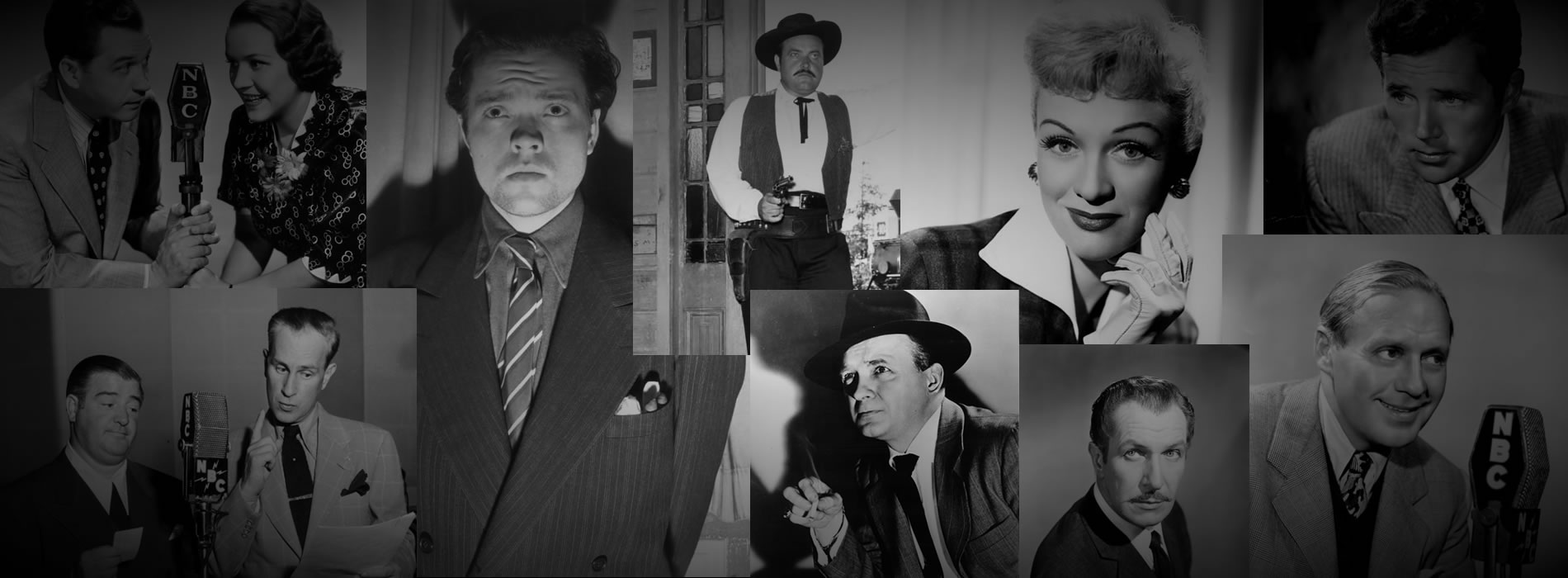
NEWSLETTER | VOL. 11, MARCH 2022
Welcome to this month’s edition of The Hollywood 360 Newsletter, your place to get all the news on upcoming shows, schedule and interesting facts from your H360 team!
Carl’s Corner
by Carl Amari
Hello everyone – here’s the Hollywood 360 Newsletter, March 2022 / Vol. 11. As someone on our mailing list, you’ll receive the most current newsletter via email on the first day of every month. If you don’t receive it by the end of the first day of the month, check your spam folder as they often end up there. If it is not in your regular email box or in your spam folder, contact me at carlpamari@gmail.com and I’ll forward you a copy. The monthly Hollywood 360 newsletter contains articles from my team and the full month’s detailed schedule of classic radio shows that we will be airing on Hollywood 360. Each month I’ll write an article on one of the classic radio shows we’ll present on Hollywood 360. The week of March 5th, 2022 we’ll be airing an episode of SUSPENSE so here’s an article on this incredible mystery series. Enjoy!
SUSPENSE
By Carl Amari and Martin Grams
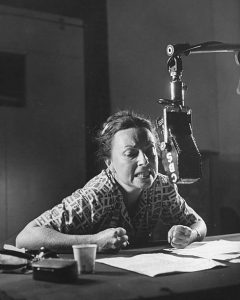 Offering high-tension drama and a stellar cast, Suspense was a landmark program from radio’s golden age. For 20 years, the program offered tales well-calculated to keep you in … Suspense!
Offering high-tension drama and a stellar cast, Suspense was a landmark program from radio’s golden age. For 20 years, the program offered tales well-calculated to keep you in … Suspense!
With audience numbers in the millions, Suspense ranked as one of the most listened-to drama programs on the air. Conceived as a potential radio vehicle for Alfred Hitchcock to direct, Suspense aired on CBS from 1942 to 1962. Known as Radio’s Outstanding Theater of Thrills it focused on suspenseful stories starring the biggest names in Hollywood.
Early in the run, the episodes were hosted by the ‘Man In Black’, who, from an omniscient perch, narrated stories of people thrown into dangerous or bizarre situations with plots that, at the very end, usually had an unseen twist or two.
Hollywood’s finest actors jumped at the chance to appear on Suspense, including: Cary Grant, James Stewart, Alan Ladd, Henry Fonda, Humphrey Bogart, Bette Davis and Orson Welles. Often times, celebrities were cast against-type including Jack Benny who played a Martian and Frank Sinatra who played a psychopathic killer. Scripts were by John Dickson Carr, Lucille Fletcher, James Poe, Ray Bradbury and many others. Agnes Moorehead (pictured performing “Sorry, Wrong Number”) was dubbed “The First Lady of Suspense” for having starred in more Suspense episodes than any other actor.
Running more than 20 years, Suspense aired nearly 1,000 radio broadcasts. It made the transition to television in 1949, but it was much better suited for radio where the theatre of the mind could run free.
LEND ME YOUR EARS | THIS MONTH’S SONG: BORN TO RUN, BY BRUCE SPRINGSTEEN RELEASED: 1975
by Lisa Wolf
“When I wrote it, I was 24 years old, sitting in my bedroom in Long Branch, New Jersey. When I think back, it surprises me how much I
knew about what I wanted, because the questions I ask myself in this song, it seems I’ve been trying to find the answers to them ever since.
When I wrote this song, I was writing about a guy and a girl that wanted to run and keep on running, never come back. That was a nice, romantic idea, but I realized after I put all those people in all those cars, I was going to have to figure out someplace for them to go, and I realized in the end that individual freedom, when it’s not connected to some sort of community, can be pretty meaningless.” ~ Bruce Springsteen
Bruce Springsteen began writing Born to Run when he was 24 years old, and it took him six months to perfect in the studio. He made numerous alterations that didn’t work, including a background chorus and various string arrangements. The first documented live performance of “Born to Run” took place at Harvard Square Theater on May 9, 1974. Springsteen’s future manager Jon Landau was in the audience, and his review of that show featured this iconic line: “I saw rock and roll future and its name is Bruce Springsteen.”
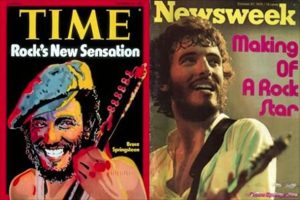 Bruce appeared on the covers of Newsweek and Time the day his Born to Run album was release – Oct. 27, 1975. During his 1976 tour in support of the album, Springsteen became the first rock act to headline Nashville’s Grand Ole Opry House (April 28, 1976).
Bruce appeared on the covers of Newsweek and Time the day his Born to Run album was release – Oct. 27, 1975. During his 1976 tour in support of the album, Springsteen became the first rock act to headline Nashville’s Grand Ole Opry House (April 28, 1976).
The guitar featured on the “Born to Run” cover reportedly cost Springsteen $185. “Born to Run” is Springsteen’s only album that has been selected for
preservation in the National Recording Registry. (2003) In 1980, the General Assembly of the State of New Jersey named Bruce Springsteen the New Jersey
Pop Music Ambassador to America.
Bondmania: Remembering the Spy Craze of the 1960s
By Barry Richert
With the release of the 25th James Bond film, No Time To Die, last October, Daniel Craig’s 15-year reign as the dapper but dangerous 007 drew to a close. While the world looks forward to (and places bets on) who will play James Bond in the future, 2022 is an opportune time to look back at Bond’s beginnings. Since the first 007 feature, Dr. No, was released in 1962, this year marks the 60th anniversary of the Bond films. Adapted from the James Bond novels by author Ian Fleming, the 007 film franchise has grown into an institution. But there was a time when James Bond was a phenomenon—a tuxedo-clad, cinematic trendsetter who found himself at the center of a pop culture whirlwind that spawned the term “Bondmania” and inspired the spy craze of the 1960s.
It all started, oddly enough, with the third 007 film. The first two, Dr. No and From Russia with Love, had been solid hits for producers Albert Broccoli and Harry Saltzman. For their next film they turned to Ian Fleming’s seventh Bond novel, Goldfinger. Released during the Christmas holidays in 1964, Goldfinger was a box office smash. Critics were effusive in their praise, and theaters had to run the film 24 hours a day to keep up with the crowds. It entered The Guinness Book of World Records as the fastest-grossing film of all time.
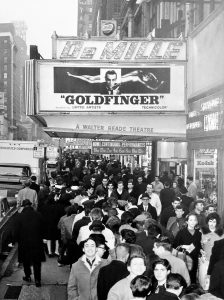 Sean Connery returned to star as James Bond, cementing his movie star status. The theme song rocketed to the top of the Billboard charts, and the soundtrack album nudged the Beatles out of the #1 spot in the U.S. A similar reception greeted the next 007 film, Thunderball, a year later (that’s right, Bond films used to come out once a year!). Thunderball became the most successful James Bond film of all time and held onto that title until the release of Skyfall 47 years later.
Sean Connery returned to star as James Bond, cementing his movie star status. The theme song rocketed to the top of the Billboard charts, and the soundtrack album nudged the Beatles out of the #1 spot in the U.S. A similar reception greeted the next 007 film, Thunderball, a year later (that’s right, Bond films used to come out once a year!). Thunderball became the most successful James Bond film of all time and held onto that title until the release of Skyfall 47 years later.
Thanks to these two blockbusters, 007 became a worldwide juggernaut during the 1965 to 1966 time frame, affecting every facet of pop culture. Everyone wanted a piece of the spy pie. Movie studios started producing spy films by the dozens—thrillers like The Spy Who Came In from the Cold, Arabesque, The Quiller Memorandum, Alfred Hitchcock’s Torn Curtain, and the Harry Palmer trilogy (The Ipcress File, Funeral in Berlin, and Billion Dollar Brain) from Bond producer Harry Saltzman.
Many of the films released during Bondmania were obvious spoofs of the 007 series, emphasizing over-the-top villains and inadequately clothed femme fatales. The more frivolous fare included Where the Spies Are, Modesty Blaise, Woody Allen’s What’s Up Tiger Lily?, The Glass Bottom Boat starring Doris Day, The Last of the Secret Agents? with comedians Allen and Rossi, The Spy with a Cold Nose featuring Disraeli the Bulldog (really), and the not so subtly-titled Licensed To Kill—also known as The Second Best Secret Agent in the Whole Wide World—and its sequel, Where the Bullets Fly.
The Vincent Price vehicle Dr. Goldfoot and the Bikini Machine was one of the more flamboyantly titled spy parodies, as was its sequel, Dr. Goldfoot and the Girl Bombs. And one mustn’t forget the films featuring Robert Vaughn as master spy Napoleon Solo that consisted of episodes from the hugely popular Man from U.N.C.L.E. television series edited together into features. Even Hanna Barbera made the leap to the big screen with the animated film, The Man Called Flintstone.
One of the most successful Bond knockoffs starred James Coburn as the unflappable Derek Flint, agent of Z.O.W.I.E. (Zonal Organization World Intelligence Espionage). Coburn’s cool-headed screen presence provided the Flint movies—Our Man Flint and In Like Flint—with much-needed gravitas, whether he was thwarting the efforts of a nefarious organization that controls the weather or foiling the scheme of an evil coterie of women who want to take control of the world’s missile sites.
If Derek Flint wasn’t outrageous enough for you, there were the Matt Helm films, which were based very loosely (seriously—VERY loosely) on Donald Hamilton’s novels. The quartet of films—The Silencers, Murderer’s Row, The Ambushers, and The Wrecking Crew—starred crooner Dean Martin, who serenaded his female co-stars as often as he rescued them. Martin foiled every diabolical plan he encountered, from laser beams capable of annihilating entire continents to the hijacking of a covert government flying saucer. The films made no attempt to take themselves seriously and clearly helped inspire Mike Myers’ Austin Powers movies several decades later.
Numerous low-budget European spy features—dubbed Eurospy films—also proliferated on movie screens throughout the mid-60s. One of the most notorious Eurospy productions was Operation Kid Brother, an Italian thriller starring Connery…Neil Connery, younger brother of Bond star Sean, as a spy whose skills include lip-reading and hypnotism. While not a film renowned for either its quality or its coherence—as its eventual appearance on Mystery Science Theater 3000 attests—it is worth mentioning for its shameless plundering of actors who had previously appeared in Bond films, including regulars Bernard Lee (“M”) and Lois Maxwell (Miss Moneypenny).
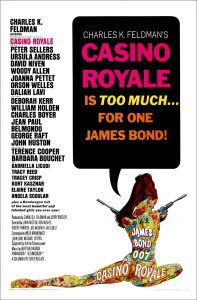 For sheer, unabashed 007 spoofery, however, there’s no topping the 1967 comedy Casino Royale from producer Charles K. Feldman, who held the rights to Ian Fleming’s first Bond novel. The farce starred such luminaries as David Niven, Peter Sellers, and Orson Welles, along with too many cameos to mention. With five directors, three credited screenwriters, four uncredited screenwriters, and no less than five characters named “James Bond,” it’s no wonder the result was a chaotic exercise in excess, playing like a series of disjointed comedy sketches in search of a narrative arc. On the plus side, Burt Bacharach’s score was superb, and the film serves as a colorful snapshot of the mod, psychedelic 60s.
For sheer, unabashed 007 spoofery, however, there’s no topping the 1967 comedy Casino Royale from producer Charles K. Feldman, who held the rights to Ian Fleming’s first Bond novel. The farce starred such luminaries as David Niven, Peter Sellers, and Orson Welles, along with too many cameos to mention. With five directors, three credited screenwriters, four uncredited screenwriters, and no less than five characters named “James Bond,” it’s no wonder the result was a chaotic exercise in excess, playing like a series of disjointed comedy sketches in search of a narrative arc. On the plus side, Burt Bacharach’s score was superb, and the film serves as a colorful snapshot of the mod, psychedelic 60s.
Meanwhile, back at home, the small screen was providing all the espionage adventures TV viewers could handle. There was the aforementioned Man from U.N.C.L.E. (which Ian Fleming had a hand in creating until pressured by Broccoli and Saltzman to pull out), as well as The Girl from U.N.C.L.E, I Spy, Mission: Impossible, Get Smart, The Avengers, Secret Agent Man, the spy/western hybrid The Wild Wild West, and for the Saturday morning crowd, Lancelot Link, Secret Chimp. One existing detective series, Burke’s Law, was given a spy makeover and became Amos Burke, Secret Agent. Alas, the overhaul did the show no favors—it was canceled at the end of that season.
Of course, what would Bondmania be without merchandise? Throughout 1965 especially, James Bond toys were everywhere. There were missile guns, walkie-talkies, wristwatches, jigsaw puzzles, board games, and a gadget-laden attaché case like Bond’s in From Russia with Love. Action figures included Goldfinger henchman Oddjob, who could throw his bowler hat by spring action (“Z-ZING! Deadly Derby Sails Through The Air!”). Bubble gum trading cards were popular, and 007 road race sets always sold well. But you weren’t a true fan unless you had a toy replica of the famous Aston Martin DB5 driven by Bond that could eject a little toy henchman out the roof of the car, mirroring a scene from Goldfinger.
Adults weren’t left out of the merchandising boom. For those who wanted to smell like Bond, there was 007 deodorant, cologne, and after shave (“…for recklessly close shaves”). Grooming yourself Bond-style was easy with 007 hair tonic, soap, and talc. To create just the right musical ambience around your swingin’ pad, John Barry’s sexy, brassy soundtracks for both Goldfinger and Thunderball were the vinyl of choice for your hi-fi. And as one might expect, Ian Fleming’s original novels were re-issued with covers showcasing artwork from the film.
By 1967 Bond fever had begun to cool down. The fifth 007 film, You Only Live Twice, was a hit, but didn’t match the box office take of either Goldfinger or Thunderball. Regardless, the effects of Bondmania would resonate for years. The spy movies that proliferated throughout the mid-60s would air on TV well into the 80s and now have a hallowed place in many home video libraries. Reruns of spy TV shows became a staple of local stations and can still be seen on many of the nostalgia channels. Spy novelties from the 60s have increased in value and can regularly be found on eBay.
And although the spy craze of the 1960s has faded into pop culture history, Bond himself has endured. Through 60 years, 25 films, and 7 actors in the role of James Bond, the 007 series has continued to break box office records, climb the music charts, and sell merchandise. Once asked in an interview how long he thought Bondmania would last, producer Albert Broccoli answered, “Until doomsday.” As the 007 franchise stands ready to enter a new era, it looks like he was right.

BETTY DEBORAH ULIUS: Writer, Director, Editor, Advocator
by Karl Schadow
In celebration of Women’s History Month, a brief overview is presented of the inspiring career of Betty Ulius. A native of New York City, Ms. Ulius’ first documented achievement in the entertainment industry, a radio script “Only the Dead Are Free” (Manhattan at Midnight, NBC-Blue) was highly praised by Ben Gross (New York Daily News, May 7, 1942) who deemed her work as from: “. . . an exceptionally promising young writer.” Indeed she would turn age 20 the following month.
After a stint on the production staff of the TransAmerican Broadcasting & Television Corporation, in January of 1944 she became continuity director of the independent WBYN in Brooklyn and also served as producer/director of the station’s weekly half-hour series, Dramatic Encore. The accolades from the critics continued when William Juengst (Brooklyn Daily Eagle, June 19, 1944) commented on a visit he enjoyed at the station: “And talked seriously, much to my own amazement, with Betty Ulius the program director, a gal who just lives for radio and really worries about the literary quality of its dramatic writing.” Additionally, in 1944 she sold two originations to the CBS radio series Grand Central Station. Was there a network invitation in the offering for the aspiring author?
 In the summer of 1944, she departed WBYN to engage life as a freelance writer successfully submitting scripts to NBC for The Haunting Hour and Five Minute Mysteries. Additional programs which featured her crafts during the late 1940s included Stars Over Hollywood and Radio Free Europe.
In the summer of 1944, she departed WBYN to engage life as a freelance writer successfully submitting scripts to NBC for The Haunting Hour and Five Minute Mysteries. Additional programs which featured her crafts during the late 1940s included Stars Over Hollywood and Radio Free Europe.
Turning to television in the 1950s, her works were performed on such ventures as Lux Video Theatre and Kraft Television Theatre. During this period she was best-known for numerous contributions to NBC Matinee Theatre. Following a move to Los Angeles in 1959, her small screen endeavors continued into the 1960s with The Millionaire and Mr. Novak. Along with E. Hunter Willett, she co-wrote the screenplay of Psych-Out (1968, American International Pictures) which starred Jack Nicholson.
Her own experience in the television and film industries coupled with the manner in which women were disparagingly portrayed in these media fueled a passion of activism. During the 1970s she was a member of Women In Film speaking out to change these archaic roles. In 1974 she joined the staff of Playgirl holding various positions as editor of the magazine’s fiction and food sections. She would later contribute a monthly column of book reviews which covered a broad array of topics.
In a 1978 Writers Guild interview, she enthusiastically admitted: “. . . the most satisfying thing that has happened in the last seven years is when I go to a workshop or something here in the Guild Theater and I see that at least a quarter to a third of the audience is women, because this is all because of the Women’s Committee.”
Betty Ulius returned to her radio roots during the late 1970s writing scripts for the Salvation Army series, Heartbeat Theatre. Moreover, efforts in a project that initially commenced in 1978 were rewarded in 1981 as thirteen, half-hour installments of Fireside Playhouse were recorded and distributed nationwide. This series featured societal problems of the 1980s that could be solved via the teaching and precepts of the Baha’i Faith. Ms. Ulius had joined the Faith in 1955. Many thespians from radio’s Golden Age participated in this enterprise including Hans Conried and Ross Martin.
Music had always had a special influence in her life (she had produced a music festival in Malibu in 1966) and had shared this affection with others. As a result of these interactions, Stephanie Merritt dedicated her 1990 tome Mind, Music and Imagery to her editor and friend. Ms. Ulius passed away on November 25, 1995 while residing in San Diego.
Acknowledgment: The author thanks Hilary Swett (Archivist, Writers Guild of America-West) for her invaluable assistance.

MartinGrams.biz: THE ORIGIN OF THIS IS YOUR LIFE
by Martin Grams
In the aftermath of World War II, there were many ex-G.I.’s recuperating from battle wounds in military hospitals; a percentage emotionally paralyzed, despairing of readjustment to civilian life. Having tapped the resources of Truth or Consequences to assist in the war effort, there was now a fresh opportunity to help in a post-war era. Little did he know that a “good gesture” act for one particular contestant, physically crippled, would ultimately lead to the creation of another successful radio/television program, This is Your Life.
“Shortly after the end of World War II, General Omar Bradley, impressed by our bond efforts, asked if we could help with the disabled veterans, particularly the paraplegics,” Ralph Edwards later recalled. “The hospital doctors told us many were afraid to go home for fear they wouldn’t be accepted and properly cared for.” Known as the “invisible wounds of war,” the result of prolonged exposure to combat-related stress, many of the wounded were depressed and reluctant – ashamed – to have family and friends see them in their debilitating condition. Edwards had multiple discussions with Al Paschall and the idea men to create a means by which the radio program could offer a second chance for veterans to advance their lives beyond a hospital bed, and double as a public service message to radio listeners from coast-to-coast.
A paraplegic at Birmingham General Hospital in Van Nuys, California, Lawrence Tranter, was selected as the first honoree. (It was at the suggestion of a doctor at the Rehabilitation Department of Veterans Hospitals, that a soldier paralyzed from the waist down be selected.) The doctors and psychiatrists were in full support that the radio program try to encourage paraplegics to talk about their past, and welcome their new future. The public needed to know the reason why the wounded, in both heart and body, were fearful of returning to their home and native communities because they felt a lack of acceptance. “We selected a paraplegic soldier from a Navy hospital in California, researched his story, and had him brought to our stage in Hollywood in a wheel chair,” Edwards later recalled. “We decided to present a young ex-Marine, Lawrence Tranter, of Murray, Utah, on Truth of Consequences and surprise him with a show of love and pride from all his family and school pals, his boss at the drug store and his favorite teacher.”
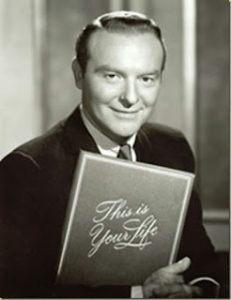 On the evening of April 27, 1946, 21-year old Lawrence Tranter, weighing a mere 91 pounds, confined to a wheelchair, paralyzed from the waist down as a result of wounds he suffered on Luzon, appeared on stage as a contestant. Mentally, prior to the radio broadcast, he was close to death. Physically, he wasn’t much better. His only control was over his fingers, which he could move freely. As usually happened when a special contestant had been “set up” in advance, he couldn’t answer the question and therefore had to pay the consequences: an emotional revisit of his past. One by one, old friends, family and neighbors, were reunited with him on stage – beginning with the chief clerk of his draft board. The profile of a returning hero was dramatized through a series of dramatic flashbacks with leading events and personalities who played a part in Tranter’s life from his high school days, through his induction into the Army. One scene dramatized the day of his birth. The appearances of friends and family were a complete surprise to Tranter. Mrs. Louise Erickson of the Murray, Utah, draft board at the time when he was inducted in 1943, spoke to him in behalf of the late Mrs. Glen Howe, who was chairman of the board when Tranter was called, but had since died. Mr. Varion Morteson, the High school principal who gave Lawrence his high school diploma spoke praise of the student who impressed his teachers. Irving Olsen, Junior Madsen and Orlan Parker, friends who Lawrence used to “gang up” at Hammond’s Ice Cream Parlor back in Murray, Utah, recollect Lawrence’s job as a soda jerk in 1940. Lawrence’s brother (Leonard) and sister (Mildred), made an appearance. Mildred was now married and has a young daughter. Dr. Warren Shepherd, the physician who brought Lawrence into the world, back in 1925, re-enacted Lawrence’s first day on Earth. Frank and Lorene Tranter, father and mother, reunited with their son.
On the evening of April 27, 1946, 21-year old Lawrence Tranter, weighing a mere 91 pounds, confined to a wheelchair, paralyzed from the waist down as a result of wounds he suffered on Luzon, appeared on stage as a contestant. Mentally, prior to the radio broadcast, he was close to death. Physically, he wasn’t much better. His only control was over his fingers, which he could move freely. As usually happened when a special contestant had been “set up” in advance, he couldn’t answer the question and therefore had to pay the consequences: an emotional revisit of his past. One by one, old friends, family and neighbors, were reunited with him on stage – beginning with the chief clerk of his draft board. The profile of a returning hero was dramatized through a series of dramatic flashbacks with leading events and personalities who played a part in Tranter’s life from his high school days, through his induction into the Army. One scene dramatized the day of his birth. The appearances of friends and family were a complete surprise to Tranter. Mrs. Louise Erickson of the Murray, Utah, draft board at the time when he was inducted in 1943, spoke to him in behalf of the late Mrs. Glen Howe, who was chairman of the board when Tranter was called, but had since died. Mr. Varion Morteson, the High school principal who gave Lawrence his high school diploma spoke praise of the student who impressed his teachers. Irving Olsen, Junior Madsen and Orlan Parker, friends who Lawrence used to “gang up” at Hammond’s Ice Cream Parlor back in Murray, Utah, recollect Lawrence’s job as a soda jerk in 1940. Lawrence’s brother (Leonard) and sister (Mildred), made an appearance. Mildred was now married and has a young daughter. Dr. Warren Shepherd, the physician who brought Lawrence into the world, back in 1925, re-enacted Lawrence’s first day on Earth. Frank and Lorene Tranter, father and mother, reunited with their son.
After the reunion on the stage, Lawrence was given a glimpse of his future… While Lawrence was in the hospital recovering, he was studying watch repair and had often said that he would like to make a life business of repairing watches.
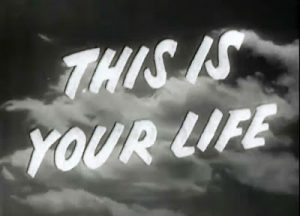 Prior to the broadcast, Ralph Edwards made arrangements with the Bulova Watch Company, located at 630 Fifth Avenue in New York City, to receive complete free training, plus a regular weekly salary, while attending the Joseph Bulova School of Watchmaking for Servicemen in New York. John H. Ballard and Arde Bulova, along with their associates, through the Bulova Foundation, had established the school for people like Tranter. Alex Cohen, in charge of public relations at Bulova, helped work out the arrangements for this radio broadcast. A place to live would be provided for Lawrence during his attendance at the Bulova School. He was also asked to choose the city in which he would like to open his own business for a jewelry store and watch repair shop… And that store would be set up for Lawrence Tranter, completely stocked with the merchandise he needed to open business, all the tools of the watch-repairing trade, and rent paid for one year in advance for the store. Meanwhile, until arrangements for Tranter’s trip to New York’s Bulova School were completed, he was provided a few days to spend in Hollywood with his family and friends who came to visit him for the radio program. (Edwards closed the ceremony by informing “the gang from Murray, Utah” to be guests at a private supper at the expense of Truth or Consequences – and, so that Lawrence would not be late for any of his “future appointments,” he received a pullover wristwatch.)
Prior to the broadcast, Ralph Edwards made arrangements with the Bulova Watch Company, located at 630 Fifth Avenue in New York City, to receive complete free training, plus a regular weekly salary, while attending the Joseph Bulova School of Watchmaking for Servicemen in New York. John H. Ballard and Arde Bulova, along with their associates, through the Bulova Foundation, had established the school for people like Tranter. Alex Cohen, in charge of public relations at Bulova, helped work out the arrangements for this radio broadcast. A place to live would be provided for Lawrence during his attendance at the Bulova School. He was also asked to choose the city in which he would like to open his own business for a jewelry store and watch repair shop… And that store would be set up for Lawrence Tranter, completely stocked with the merchandise he needed to open business, all the tools of the watch-repairing trade, and rent paid for one year in advance for the store. Meanwhile, until arrangements for Tranter’s trip to New York’s Bulova School were completed, he was provided a few days to spend in Hollywood with his family and friends who came to visit him for the radio program. (Edwards closed the ceremony by informing “the gang from Murray, Utah” to be guests at a private supper at the expense of Truth or Consequences – and, so that Lawrence would not be late for any of his “future appointments,” he received a pullover wristwatch.)
In New York, the Joseph Bulova School of Watchmaking had been established to teach a craft to veterans who needed a new field in which to earn a living. Since Tranter had not yet recovered sufficiently from his injuries for the hospital to allow him to travel to New York immediately following the program, Gen. Omar Bradley and the Veterans’ Administration requested the Bulova School to open a branch at Tranter’s hospital. Once he was well enough, he would go to New York and complete his studies. Between tears of joy, the war veteran accepted the proposition. And, according to two separate accounts from staff members who were involved with the surprise consequence, there wasn’t a dry eye in the audience.
Edwards closed the act with these words: “This is a great example of what an industry can do to help the disabled veteran. Boys paralyzed as Lawrence Tranter or otherwise disabled in battle. The Veterans’ Administration hopes other industries will set up similar rehabilitation programs for veterans in hospitals. Training courses such as this help speed the recovery of these disabled G.I.’s and it may start them on a new career as it did Lawrence. Those boys didn’t forget you, folks. Let’s not forget them.”
On Truth or Consequences, surprising a contestant with family relatives was done a number of times, especially for soldiers stationed at training bases during the War who longed to see their mother, wife and/or children. The war might have been declared over, but the urgency of family reunions was still essential. Emotions rose on stage and in the studio audience, attesting Edwards succeeded beyond anything he and his crew expected. If there was any question whether the quiz program succeeded in delivering a public service message, there could be no doubt by the letters, telegrams and feedback, numbering in the thousands.
“I have been advised by our Radio Director, Mr. Brechner, of your help in preparing the Truth or Consequences radio broadcast of April 27 involving a patient from the Birmingham Veterans Hospital. This outstanding broadcast, which I thoroughly enjoyed, was a fine contribution to our Medical Rehabilitation Program. Will you please accept my thanks and extend my appreciation to Mr. Al Pasqual and other members of your staff who helped prepare this worthy broadcast.”– Omar N. Bradley, General, U.S. Army, Administrator of the Veterans Administration
“I listened to your very fine program on April 27, 1946, and I want to express my great appreciation to you for your fine work in the rehabilitation of Lawrence Tranter, Murray, Utah. This young, according to your introduction, served in the Philippines and was wounded there while taking part in the Liberation of the Philippines. It gave me a great sense of pride to learn that he had received a disability that would perhaps handicap him for the rest of his life The great deed that you have performed in his rehabilitation and of other young men deserves great praise and I hope that you and others will continue the good work for the men who have given all they had for humanity.”– Joseph P. Hyman, National Commander of the
National Society – Army of the Philippines
“I listened to Truth or Consequences Saturday night and still can’t get the show out of my mind. I’ve heard many human interest spots before, and during the war had occasion to handle a number of them myself, but can honestly say that I have never heard anything done so well.”– Warren Lewis of the National Broadcasting Company
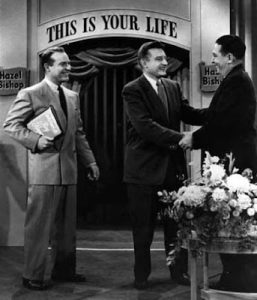 Ralph Edwards did not forget Lawrence Tranter. Almost two years later, on the evening of April 24, 1948, the same chair was wheeled up to a microphone on the Truth or Consequences stage. Tranter had begun a new interest in life. He became mentally stimulated because he had found something to occupy his alert mind and supple fingers. He learned a trade and improved physically. Tranter had completed his course and put on 45 pounds. Edwards moved over to Tranter’s microphone to bestow his promises: a lease for the store which Tranter then signed; a check for the first year’s rent; an inventory of the stock guaranteed in writing; and a $1,000 check to open the store’s bank account from John Ballard and Ardie Bulova of the Bulova Foundation. Edwards then informed Tranter that a group of Salt Lake City jewelers had formed a committee to help him with the number plate for his store: 4881 South State Street, in his hometown of Murray, Utah.
Ralph Edwards did not forget Lawrence Tranter. Almost two years later, on the evening of April 24, 1948, the same chair was wheeled up to a microphone on the Truth or Consequences stage. Tranter had begun a new interest in life. He became mentally stimulated because he had found something to occupy his alert mind and supple fingers. He learned a trade and improved physically. Tranter had completed his course and put on 45 pounds. Edwards moved over to Tranter’s microphone to bestow his promises: a lease for the store which Tranter then signed; a check for the first year’s rent; an inventory of the stock guaranteed in writing; and a $1,000 check to open the store’s bank account from John Ballard and Ardie Bulova of the Bulova Foundation. Edwards then informed Tranter that a group of Salt Lake City jewelers had formed a committee to help him with the number plate for his store: 4881 South State Street, in his hometown of Murray, Utah.
With the formalities over, Edwards walked back to his own microphone and said, “Oh, Lawrence, there’s just one more thing. You can’t get in the store without a key. Here’s the key, fellow… come and get it. Remember, two years ago they said you’d never be able to get out of that wheelchair. This is the future, Lawrence. This is your key to the store. Come and get it.” Slowly, Tranter rose from the chair. Leaning on a large table, the ex-Pfc. made his way across the stage, slowly walking, and took the key. “I had purposely encouraged this to demonstrate the tremendous rehabilitation that had taken place in the boy’s previous physical and psychological deficiencies,” Edwards later explained. “The audience stood and applauded.” Tranter could now get along with crutches.
It was during this broadcast that Tranter had a surprise for Ralph Edwards. He announced that he had gotten married four months earlier, and introduced his wife, Dorothy. She was the lovely red-haired lady who served as his nurse at the Bulova School of Watchmaking. Together they stood on stage for the official presentation of his diploma from the Bulova School of Watchmaking, made by former head of the Veteran’s Administration, Chief of Staff of the Army, General Omar Bradley, speaking from Washington, D.C.:
“Hello, Lawrence. I’m going to step out of my job as a soldier for just a minute this evening to back to those days when we were working for you in the Veterans’ Administration. I like to recall them because they were busy and productive days when we could do a little for those of you who did so much for us. Tonight, as you leave the Bulova School, as you put the hospital behind you to take your place as a business man in your home town, you are helping to prove what millions of veterans everywhere have claimed when they say to the American people, ‘Give us the chance – give us the opportunity – and we will make good.’ Lawrence, the burden of proof is not so much upon you as it is upon us, the American people, to whom you have come back. For it us up to us to show you that democracy is the measure not only of a man’s personal freedom but his economic opportunity as well. If only we will remember that this great country of ours is peopled by young men like you, men and women with the spunk and courage to make it an even better place in which to live, we will make democracy mean a great deal more to our children – yes, and to the puzzled people who live tonight in nations around the world. Again, congratulations. My good wishes to you and Mrs. Tranter for a full and happy lifetime.”
Ralph Edwards thanked General Bradley and then spoke the works he was to repeat many times to millions of radio listeners: “This is your life.”
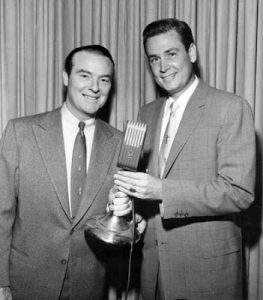
Bob Barker and Ralph Edwards
Behind the scenes, the Decker Jewelry Company, wholesale jewelers, supplied the opening stock for the store. As promised on the broadcast, Tranter was given a completely-stocked jewelry store, including electric sign, all interior fixtures, window trims, a watchmaker’s bench, a safe, interior work, and other necessities. The merchandise itself, the bill of goods, was given to Lawrence Tranter. The Bulova Watch Company agreed to underwrite his credit, but Tranter had to pay for the merchandise. His stock, like any business, was to be paid for out of his profits, since, of course, he would be selling the goods and realizing the difference between the wholesale and retail price. Edwards explained this to Tranter on the evening of his initial consequence, and reminded on the evening of his return to the program, and Edwards himself agreed to underwrite his credit to the extent of $500. When it was discovered that $500 would not even complete window dressing for one of the two display windows, the Murray City Chamber of Commerce got involved and explained to Edwards that tentative dates set for the grand opening of the store had been pushed back to ensure the store would be fully furnished as promised on the program. As a result, Bulova extended Tranter with $2,000 worth of credit.
His first customer was supposedly Gov. Herbert B. Maw of Utah.
The Lawrence Tranter broadcast was so overwhelming that Ralph Edwards discussed the proposal of doing a weekly “good gesture act” covering the life of an exceptional individual who deserved more than verbal gratitude. A few months later Truth or Consequences featured a consequence imposed on Lester Hansen, who was asked to “act” in a little dramatization in which he was assisted by radio actors Jack Moyles and Iva Green. The dramatization portrayed the actual heroism and experiences of the veteran, but the contestant was not aware until he read the “script” that he was acting out his own story. For his efforts as an actor and in recognition of his exploits during the war, Lester received a $1,000-diamond engagement ring (and wedding band to match) to give the girl he was marrying soon; a complete wardrobe for civilian life including two Hart Schaffner Marx suits and top coats; and all-expenses-paid for equipping his new car (he already had the car) so that he would be able to drive it without using his disabled limbs. Truth or Consequences arranged this special equipment for the car through consultation with the vet’s hospital.
Lester Hansen, 28, was paralyzed from the hips down. An artillery lieutenant in the war, Lester Hansen was wounded in the back in a battle on Biak Island, a dot in the Pacific Ocean off New Guinea. After two and a half years spent in army hospitals at Walla Walla and Los Angeles, he was discharged from the army as a major. In 1947, he was 28 years old, busy laying out a doctor’s career for himself. He was living in Los Angeles with his wife, Ethel, whom he married less than a year prior after meeting her in the Walla Walla hospital, where she served with the Red Cross. Doctors were puzzled by Hansen’s ailment, saying they knew no reason why he could not walk, except that nerves had been shocked. And, they claimed, another great shock might undo the damage and enable Hansen to walk again.
Two days later, on October 6, 1948, an audition disc was recorded (never aired) focusing on the life of Lester Hanson, a paralyzed war veteran from Spokane, Washington. Hosted by Harry Von Zell, who would obviously be replaced by Ralph Edwards when the radio program premiered in November, the demo was played back for potential sponsors. Hanson played the role of a “surprised” guest, with full understanding that his demo could convince a sponsor and a network to feature a similar program on a weekly basis.
The first radio broadcast of This is Your Life aired on the evening of November 9, 1948. Sponsored by Philip Morris and broadcast over NBC, the premiere episode was modeled after the Lawrence Tranter show, which was the forerunner of This is Your Life. Paul Jackson, a paraplegic, was chosen to be the first “victim” of the new radio program. Jackson was wounded and buried in the snow in the Battle of the Bulge. A medic tripped over him and saved his life. Jackson never knew who the medic was so Edwards and his crew ran down the files and presented to Jackson the young man responsible for saving his life. For his future, they provided complete equipment for a gun shop in a place he was starting in Tulare, California.
And now the good news…
A complete inventory was recently made on the scripts, along with Ralph Edwards’ personal scrapbooks, newspaper clipping files, photographs and loads of other materials pertaining to the radio version of This is Your Life was recently unearthed and digitally scanned. Unlike the television version which glamorized celebrities, the radio version for the most part focused on every day citizens and until now proved a challenge identifying exactly who each of the “contestants” were — until now. Crossing fingers, all of this material may go to print in book form within a year or two. Again, crossing fingers…
Hollywood 360 Schedule
3/5/22
Suspense 6/29/44 The Walls Came Tumbling Down
Baby Snooks & Daddy 5/1/51 Report Card Blues
The General Electric Theater 7/9/53 Random Harvest
The New Adv. of Nero Wolfe 1/19/51 The Case of the Calculated Risk
Our Miss Brooks 11/21/48 Snap’s Magazine Model American Teacher
3/12/22
Gunsmoke 11/21/52 Fingered
FBI In Peace and War 5/18/55 The Fast Pace
The Fred Allen Show 3/20/49 Mob Buster
Lights Out! 2/23/43 The Met at Dorset
Pat Novak, For Hire 8/10/47 Jack Landsome – Burke Papers
3/19/22
Fibber McGee & Molly 11/3/42 Duck Hunting with Mayor LaTrivia
The Cavalcade of America 9/13/43 Iron Camels
My Friend Irma 1/6/52 Memoirs
Crime Does Not Pay 11/28/49 Female of the Species
Wild Bill Hickock 12/22/52 The Rustlers of Rattlesnake Bend
3/26/22
Screen Guild Theater 1/25/43 Across the Pacific
Archie Andrews 5/18/46 Jive Talk
Inner Sanctum Mystery 1/22/46 The Confession
Life With Luigi 4/1/52 April Fool’s Joke
Mr. & Mrs. North 1950s Cry Foul
© 2022 Hollywood 360 Newsletter. The articles in the Hollywood 360 Newsletter are copyrighted and held by their respective authors.

